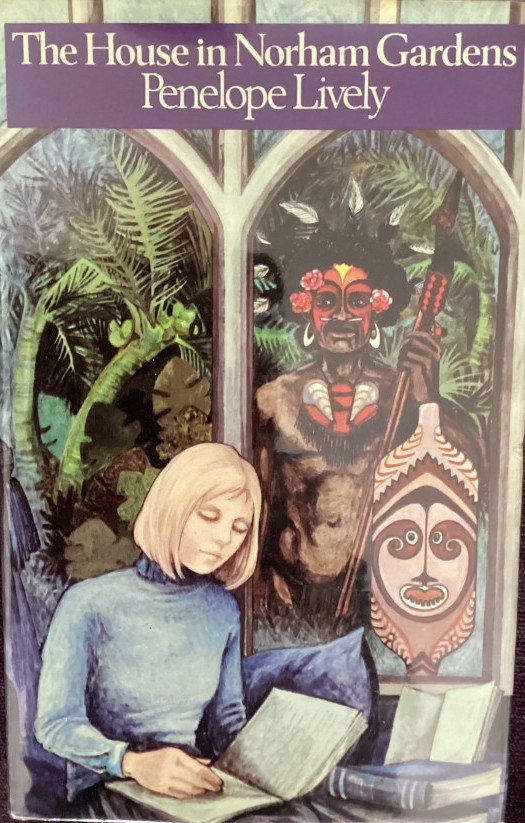Inspiring Young Readers
 posted on 03 Aug 2023
posted on 03 Aug 2023
The House in Norham Gardens by Penelope Lively
Penelope Lively’s The House in Norham Gardens has been sitting unread on my shelves for decades. Somehow, even when looking for titles to read as part of Letterpress’s continuing exploration of 1960s and 70s children’s fiction (this post links to many of the reviews), I managed to ignore it. A few days ago I finally put this right.
If I hadn’t checked, I would have felt confident in saying that this was probably Lively’s first novel because it seemed to have all the hallmarks of a debut – impeccable atmosphere and exquisite descriptive writing, both sometimes at the expense of plot, and a strong autobiographical tendency. But it isn’t: it is her sixth, coming after some of her much better known and more highly acclaimed titles, such as The Whispering Knights, The Wild Hunt of Hagworthy (review) and The Ghost of Thomas Kempe (review).
First published in 1974, I think the setting is actually a few years earlier, perhaps 1969 or 1970. Clare Mayfield, a fourteen year-old orphan, lives with two ageing great-aunts in a vast, crumbling Victorian house in north Oxford – the house of the title. The aunts have looked after Clare since she was orphaned at the age of eight, her parents having been killed in an air crash. I suspect the aunts are almost certainly a portrait of the kind of women Lively herself knew as a teenager – upper class, academic, the left-wing intelligentsia of their day, slightly bohemian, now living in genteel poverty, a busy life of research and committees and social and political campaigning behind them.
It is deep winter and the bitter cold and persistent snow and lack of heating and the mounting burden of work Clare needs to do in order to help keep the precarious household afloat are central to the story. The increasingly out-of-touch and sometimes frail great-aunts are absolutely central characters – but so is the weather, the house and Oxford itself.
But to my mind there is a problem, and that is that beyond this – a sort of hymn to the importance of the ordinary – it isn’t always clear that Lively has quite worked out how best to move the narrative forward. It is almost as if, having set aside the fantasy of her earlier novels for children, she is seeking a new method, a new kind of fiction that isn’t dependent on magical adventures, and hasn’t yet fully decided how to approach this.
For example, there is an important story element that involves the anthropological expeditions to New Guinea of her great-grandfather, and the artefacts – especially a ceremonial shield, a tamburan, central to how the tribe’s ancestors are remembered and honoured – which she finds in the attic of the great-aunts’ house. For a period it seems that the shield itself or perhaps simply her more general reflections on the expeditions her great-grandfather made are causing her to have disturbing, almost visionary dreams. But ultimately, this strand of the story – which does have a subtle undercurrent that may be magical – is rather swiftly despatched. A little later Clare meets a friendly young African man, a Ugandan student who is studying in Oxford and almost as lonely as she is. There is a tentative relationship, he even comes to lodge at Norham Gardens– a second lodger, in fact: they are essential to the household economy – but this too rather fizzles out and by the end of the book he seems to have become closer to Maureen, the other lodger, than to Clare.
And yet I admire Lively’s determination to resist pat endings and to try for something harder and more demanding, because ultimately I think that is what she is doing. For the real heart of this story is Clare’s desperate fear of her great-aunts’ death and her growing realisation that there is nothing she can do to prevent this. There is, however, a lot she can do to ensure that her memories of the aunts are as rich and rounded and as meaningful as possible. She begins to understand that her role – as illustrated by the indigenous people of New Guinea that her great-grandfather wrote about, and by what the young Ugandan student has told her of his own family – is to ensure that her elders and ancestors are memorialised, their contribution to the world remembered, their continuing importance in life recognised.
Ultimately I found The House in Norham Gardens a frustrating read: it is so nearly a great book for young adults – sophisticated, beautifully and scrupulously written and considering difficult and demanding ideas without at any point reading like an ‘issues-based novel’. Its very particular picture of early-1970s Oxford is alive and breathing on the page. But I didn’t feel that it quite succeeded as a novel and even at only 150 pages or so, it felt a little too long at times. Even so, it left me admiring Lively’s work more rather than less, impressed by the scale of her ambition and her quiet, unshowy attempt to forge a new kind of fiction for young people.
Alun Severn
July 2023
Stag Boy by William Rayner – this post has links to many recent Letterpress reviews of 1960s and 70s children’s literature